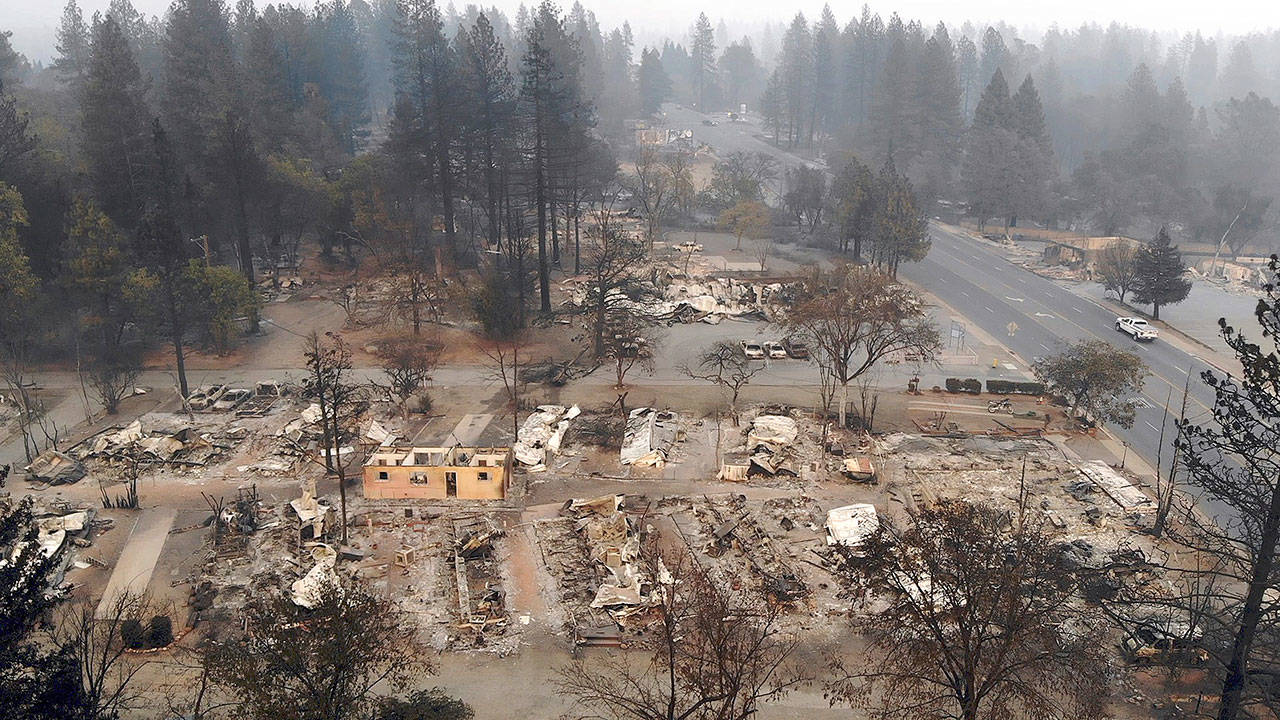By Hannah Fry and Joseph Serna
Los Angeles Times
The fast-moving Woolsey fire has charred 91,572 acres, destroying an estimated 370 homes and businesses in Los Angeles and Ventura counties, officials said Monday.
Meanwhile, a new fire broke out in Simi Valley, closing both sides of the 118 Freeway.
California Department of Forestry and Fire Protection officials said about 15 percent of the burn area has been surveyed for damage, so the number of structures destroyed or damaged in the inferno likely will increase. About 57,000 structures are still threatened.
A lull in winds over the weekend allowed firefighters to put containment lines into place. However, Santa Ana winds arrived Monday morning and were expected to gain strength through today, which could cause the fire to spread erratically, said Cal Fire Division Chief Chris Anthony.
Northeast winds are expected to blow 20 to 30 mph with gusts up to 55 mph in Los Angeles, according to the National Weather Service. A red flag warning — signifying a potent mix of heat, dry air and winds that could explode a small fire into a deadly conflagration — has been issued for the region.
Anthony said the main push for firefighters through Monday was preventing burning embers from jumping outside the containment lines, and keeping the blaze from spreading to Topanga Canyon. The fire was 20 percent contained as of Monday afternoon.
“We didn’t see any spread of fire outside the containment lines on Sunday, but as we’ve clearly seen over the last couple of days, it only takes one ember and one new spark to see rapid rates of fire spread,” he said.
The fire has killed two people, authorities said.
Investigators are still trying to determine what sparked the fire. Southern California Edison told state regulators that there was an outage tied to its Chatsworth substation two minutes before the fire was reported near Simi Valley, but authorities have not connected the incident to the fire.
“At this point we have no indication from fire agency personnel that Southern California Edison utility facilities may have been involved in the start of the fire,” Edison wrote in an incident report to the California Public Utilities Commission.
Edison wrote that a circuit relayed at the facility at 2:22 p.m. Thursday. Sally Jeung, a spokeswoman for Edison, told KQED-TV that “when a circuit relays, (it) senses a disturbance on the circuit and switches the circuit off.” It’s not clear what triggered the circuit’s sensor.
Edison said that at the request of firefighters, it might turn off power Monday in certain areas affected by the fire, but that such steps had not been needed as of press time.
Officials urge residents who are sheltering in place to evacuate and those who already have left their homes to stay away.
“Maybe 10 or 20 years ago, you stayed in your homes when there was a fire, and you were able to protect them,” Ventura County Fire Chief Mark Lorenzen said Sunday. “Things are not the way they were 10 years ago.”
Malibu, Calabasas, Hidden Hills, Monte Nido, Gated Oaks, Topanga, Bell Canyon, and portions of Westlake Village and West Hills remained under evacuation orders on Monday.
The evacuation order for Agoura Hills was lifted early Monday, with residents being allowed to return home, according to the city.
While strong winds will continue to be a significant factor for firefighters in Southern California, those battling the Camp Fire in Butte County got a slight reprieve Monday from gusty weather that had been complicating the fight since last week.
The Camp Fire, which has charred 113,000 acres and destroyed 6,700 homes and businesses, is the deadliest and most destructive blaze in state history. The search for additional victims in Paradise continues.
A red flag warning that has been in effect for days was set to expire on Monday, the National Weather Service said.
But as commanders warned crews during their morning briefing at the Silver Dollar Fairgrounds in Chico on Monday, that doesn’t mean the fight against the Camp Fire is anywhere near won. The fire grew overnight and was 25 percent contained Monday morning, officials said.
Most of that spread was on the blaze’s northeastern flank toward Sterling City and deeper into the Sierra Nevada and to the southeast, where it jumped the Feather River, officials said.
The fire is expected to transition from being wind-driven to fuel- and topography–driven, making it more predictable, but still potentially explosive as it approaches overgrown, tinder-dry landscape.
On Sunday night, the fire’s northeastern flank pushed toward Stirling City, another isolated mountain town with few exits and entrances and surrounded by forest.
“Very heavy jackpots of fuel out there. There are some areas with some thinned-out forests, however most of it is really heavy,” said Jonathan Pangburn, a fire behavior analyst with Cal Fire.
The landscape’s susceptibility to fire can’t be understated, fire officials said. Three times Sunday night, the blaze jumped a 300-foot lake thanks to red-hot embers that landed on some parched grass and triggered another fire, Pangburn said.
“Areas where you’d expect the fire to not necessarily continue forward in previous years, the fuels are just too dry,” he said.


